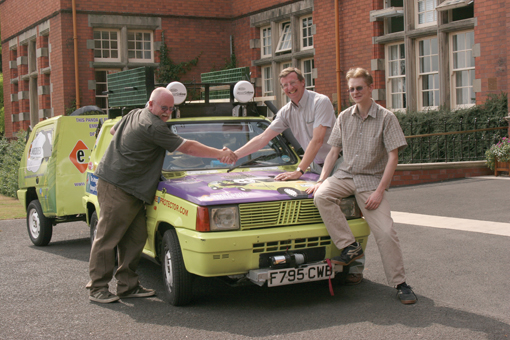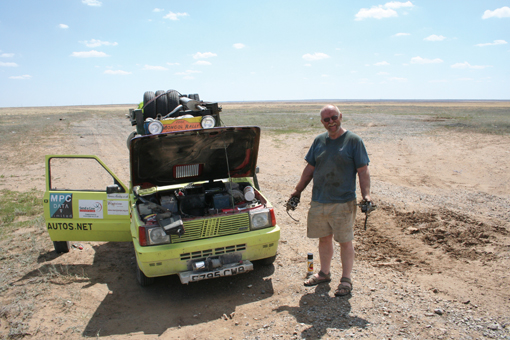NationalRural was established in 2004 as a Knowledge Exchange - a service provided by universities and colleges for rural businesses and organisations. The project was set up with funding from HEFCE as one of 22 Centres for Knowledge Exchange activity in the country. NationalRural represented a collaboration of 14 universities and colleges with its influence extending to many other universities and colleges with rural interests and expertise. Following on from the funded phase of the project, its online service - the NationalRural Directory, has been retained. It is supported and maintained by Harper Adams University. Roger Greenhalgh, Head of Information Services at Harper Adams University College, describes their work and their experiments in time lapse video.
 About the author: Roger Greenhalgh is the Head of Information Services at Harper Adams University College. His publications include: Constructing virtual resources for practitioner communities: a 'space for all reasons' RCDL 2010 Digital Libraries: Advanced Methods and Technologies, Digital Collections 2010 (University of Kazan, Russia).
About the author: Roger Greenhalgh is the Head of Information Services at Harper Adams University College. His publications include: Constructing virtual resources for practitioner communities: a 'space for all reasons' RCDL 2010 Digital Libraries: Advanced Methods and Technologies, Digital Collections 2010 (University of Kazan, Russia).
For further information about NationalRural, visit their homepage at: www.nationalrural.org
This article was originally published in Viewfinder in 2007.
Type ‘London to Brighton in 4 Minutes’ into Google, and you’ll find a wealth of references to a classic black and white short film from 1952, taken from the cab of the ‘Brighton Belle’. The individual time-lapsed frames when put together created the illusion of a train journey experienced at 765 mph. Apparently the cameraman had to hand-crank the camera at two frames per second instead of the usual twenty-four for the entire journey. Every so often he would run out of film and had to change the roll, so to hide the resulting gaps, a view of the train driver at the controls was duly edited into the final cut.
On the fiftieth anniversary of the line’s electrification, the BBC recreated the film as a three-and-a-half-minute filler, and it was first broadcast on Friday evening, 15th July 1983, just after the magazine programme Nationwide. It was subsequently used as a short programming filler many times throughout my son’s childhood, and so has become entrenched in my family’s personal nostalgia.
Fifty years onward from the original London to Brighton in 4 Minutes and this seed found its way into our planning for documenting a recent overland journey from the Midlands to Mongolia. At NationalRural our project has become used to finding innovative IT solutions with the limited resources avalable, and this one fell into our lap though sheer serendipity. There were some politics, too. NationalRural is a multi-university collaboration project, and when two key members of the IT team headed off eight thousand miles eastward, finding a way of informing the troops back at home about what they are doing kept people (relatively) happy! It was a charity-sponsorship trek too and at the end of the day we needed to provide the sponsors with something offbeat as well.
On the surface, mounting a digital camera into a car, capturing images from it at regular intervals, and editing them together to condense three weeks of travel into a five-and-a half hour multi-part epic looked easy. The devil, however, is in the detail… The clue is in the name. The sponsored trek was the 2006 Mongol Rally. Its annual challenge is to drive unsupported from the UK to Ulanbataar in a car of 1000 cc’s or less. It involves deserts, dust, unbelievable and often invisible roads, heat, vibration, bandits and borders, zero concentration and zilch communications, and a budget of ninepence. Not one of these is conducive to capturing lots of nice images in sequence, reliably, to a hard drive, let alone getting them home again, and remembering precisely where each one was recorded.

(image: Sam Greenhalgh, HAUC)
Let us begin with the basics. The cameraman on the ‘Brighton Belle’ had 30 minutes worth of images to capture, and he had to handle a number of film roll changes. Fortunately, though, being part of the digital generation means we should be able to use more convenient media. So, what sort of volume of image data would eight or ten hour’s worth of continuous driving be likely to generate? We decided to be pragmatic. At the end of each day we wanted the comfort of being able to write everything we’d captured onto a single CD. The capacity of a CD lets you hold about 600 Mb of data, so the arithmetic is fairly simple. At a frame every two seconds, you will generate 18,000 images in ten continuous hours of driving. You can just squeeze that onto a CD if each image is under 300K. So, that tells us that we’ll get away with using a good webcam.
There were some questions, though, that watching the Brighton Belle film didn’t answer, and no amount of discussion made any clearer. In true empirical spirit, homage to Scrapheap Challenge and with the Fred Dibnah approach to engineering, sometimes you just have to have a go and find out. My colleague Sam knocked up a quick and dirty computer application that sat on a Windows XP laptop in the footwell of the car, and captured images from a webcam at 2 second intervals. We drove up and down the A41 and bored our friends to death with drive-throughs of wet Shropshire tarmac, while we toyed with the software. Should the frame-rate be constant, or should it rise and fall directly or inversely with the speed of the car? If you crawl for 60 seconds in a traffic queue, do you still grab the same number of frames as when blasting along the motorway for a whole minute? In our quest to keep the data volume down by changing that, would we upset the final visual effect?

Professor Wynne Jones, Principal of Harper Adams University College, sees the team off at the start of their journey (photo: David Chadwick, HAUC)
Variable frame rate, although elegant, turns out to be really unhelpful. Essentially, at high speed your brain still needs to register sufficient continuity from one frame to the next. If you don’t see the same telegraph poles and bridges pass by gradually from one frame to the next, the perception of motion is lost. If you suddenly leap from one side of a roundabout to the other and the blue car in front instantly becomes a red one, the viewer loses orientation. There’s only just so much ‘suspension of disbelief’ that a viewer can accept, and so a fixed frame rate, where the viewer still perceives the changes in velocity, give a more credible experience than trying to create an illusion of more constant progression across the geography.
While we were playing with the geography, we spent the vast sum of £99 on a handheld Garmin GPS unit. It conveniently has a USB data cable, and can therefore be persuaded to feed a stream of latitudes and longitudes to the computer application. Irritatingly, though, its alternative power cable uses the same port, so to run the unit continuously powered for three weeks calls for some innovative surgery with a soldering iron. We originally planned to use this to drive the variable frame rate, but when this proved unnecessary, settled for having a log of precise locations for where every frame was taken.
The application worked well, and we were soon producing GPS-logged video snippets of half-hour trial roadtrips around the Midlands, writing data to the laptop. But Shropshire and the lands beyond the Urals are a world apart in terms of highway technology, and we knew that we wouldn’t always have this luxury of smooth road surfaces and mild climate. We’d seen plenty of hand-held footage on YouTube from past Mongol Rally participants, and we knew that many of the previous entrants’ vehicles had suffered a variety of structural failures from the vibration. If spot welds and engine mountings fail under this punishment, then what chance do disc drives have? As the average motorist learns. drive your car over a pothole a bit fast with your CD player running, and you’ll hear the music skip. The hard-disc issue is an extreme version of this same phenomenon.
The mechanism of a hard disc drive is a league beyond writing to cassette tape. It involves floating a read/write head a fraction of a millimetre above the highly-polished spinning surface of the drive platter, and controlling its position quite precisely. The platter spins at around 7,000 rpm, which gives it a surface speed of about 170 mph. In order to transfer data quickly to or from any part of the disk, the head can be moved laterally and precisely across the entire disc radius anything up to 50 times per second. So, even though an element of disturbance from vibration can be catered for by damping, the greatest risk from vibration is to cause a crash of this drive head into the rapidly spinning surface fractionally below it. With the speed and momentum involved, one disc crash like this is fatal and effectively unrecoverable.
Superficially, the answer to the vibration problem looks simple… don’t write to a hard-drive – keep the data in memory, or write it to a solid-state drive (which is effectively the same thing). Solid-state means no moving parts, so it’s just the equivalent of using a huge USB memory stick. These little solid-state pluggable memory cards seem over the last few years to have completely replaced the floppy disc, you can buy them in the high street, and they can hold a few gigabytes. So, a memory stick might be a step in the right direction… but you still can’t fit Windows XP on one. As well as writing data to a drive, the Windows operating system also uses the drive… it loads up from there, and it caches to there every now and again, all the time that it’s running.

(photo: Sam Greenhalgh, HAUC)
This led us to look at finding a small enough operating system that would run our application, and still fit in its entirety onto a solid-state memory card, and fortunately we found that in Windows Embedded. This is essentially the Windows XP operating system cut down and bundled into a series of components. You only install the particular components that you need, so the operating system can be trimmed down to the absolute barest minimum. It’s not exactly an out-of-the-box solution, as getting all the correct bits of Embedded onto our little solid-state PC needed the intellect and laying on of hands of the technical chaps at Abacus, but it did do the trick.
The chosen PC? £100 from Ebay found us an ultra small form factor Dell Optiplex. These tiny desktops machines are largely built from the same components that are used in laptops and are about two and a half times the size of a car radio. The laptop-style construction let us run this off the standard 12v circuitry of the vehicle, and we added in the failsafe of equipping the car with twin 12v car batteries using a split-charge circuit – which protected the continuously running computer from power-dips and surges such as when starting the car, (and gave us a failsafe in case one battery should run down!) Its processor is fitted with a huge heat sink, and even in the forty-odd degrees of the Kazakh desert, its little internal fan would periodically fire up and waft a token stream of dust-laden air across it. After three solid weeks it looked as though it had been caked in cement – but it did still do the job!
The camera never lies. (But sometimes you wish that it would.) In Poland we asked the TomTom GPS system to take us to ‘Cracow’, but unfortunately there’s also a similarly named ‘Cracau’ in Germany. The footage shows us blithely entering Germany, realising that we appeared to have crossed the wrong border and in the wrong direction, turning round and eventually heading back to Poland. Even with a GPS, it seems, the old adage of ‘Garbage In, Garbage Out’ still applies!
At one point, we took an intentional detour through the Chernobyl exclusion zone. The road footage, compressed into its 10 minute high-speed dash across deteriorated roadways with occasional pauses to ‘assist’ our way through control points with the aid of ‘gifts’, shows little of the sadness of this forsaken area, except to show that the word ‘exclusion’ is a misnomer. There are plenty of people still eking a humble and sorrowful existence there, with all the infrastructure left in tatters.
Later, the 50 km bounce along the arid Kazakh plain to what was once the Aral Sea shows with its constantly leaping and shifting horizon the hammer that the vehicle was taking. Unfortunately the viewer has little concept that the starts and stops in that compressed 23 minutes are the only visible symptoms of the loss of two road wheels, and third and fourth gear, (fifth gear and the brakes had long gone by then!) But frame by frame the computer carried on, now in its third continuous week of running. 24 hours later, after a slow crawl in second gear to Zhasaly, we committed the remains of the Fiat Panda to its final resting place, packed the Dell, the webcam and a tin of very dusty CDs into our rucksacks, and caught the next Transiberian train back to the West.
Roger Greenhalgh